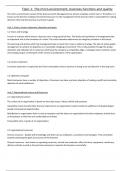2
Outline
- 23.1 Respiratory system anatomy
- 23.2 Pulmonary ventilation
- 23.3 Lung volumes and capacities
- 23.4 Exchange of O2 and CO2
- 23.5 Transport of O2 and CO2
- 23.6 Control of breathing
L5 - Homeostatic imbalances
BSP312 – Effects of exercise; high altitude physiology, hyperbaric physiology
3
Lecture 1 – Respiratory Anatomy
OBJECTIVES:
1. Describe the major functions of the respiratory system.
2. Distinguish between the upper and lower respiratory tracts and list
the components of each.
3. Distinguish between the functions of the conducting and respiratory
zones and list the components of each.
, 4. Identify and describe the main anatomical features and functions of
the following: nose, nasal cavities and paranasal sinuses, mucous
membrane, pharynx, larynx, trachea, bronchial tree, lungs, pleura,
alveolar wall.
5. Describe the circulation of both oxygenated and deoxygenated
blood to the respiratory system.
6. Explain how the respiratory exchange surfaces are protected from
inhaled particles.
4
Introduction
Respiration = gaseous exchange between cells and atmosphere;
includes the following processes:
• Pulmonary ventilation = breathing
• External respiration = exchange of O2 and CO2 between
alveolar air and pulmonary blood
• Internal respiration = exchange of O2 and CO2 between
cells and systemic blood
5
, Respiratory System Anatomy
Composed of airways that
conduct air in and out of alveoli Upper
(150 million/ lung)respiratory tract
Structural classification:
Lower
– upper respiratory tract respiratory
– lower respiratory tract tract
Functionally classification: Nasal cavity
– conducting zone Pharynx
Larynx
– respiratory zone
Trachea
Primary bronchi
Secondary bronchi
Tertiary bronchi
Bronchioles (terminal, respiratory)
Alveoli (150 million/lung)
🎦 Respiratory System Anatomy animation
6
Respiratory System Functions
1. provides for gas exchange of O2 and CO2
2. pH regulation
, 3. olfaction
filters inspired air phonation excretes
small amounts of water and heat
7
Nose & Nasal Cavity
Structural features:
– External nares
– Vestibule
– Nasal cavity
– Hard and soft palates
– Nasal conchae (turbinate bones)
– Olfactory region
– Paranasal sinuses
– Internal nares – Mucosa
(mucous membrane)
Functions:
– Detects olfactory stimuli
– Resonating chamber
– Filters, warms, humidifies
inhaled air
8
Clinical Connection:
Rhinoplasty
8
Outline
- 23.1 Respiratory system anatomy
- 23.2 Pulmonary ventilation
- 23.3 Lung volumes and capacities
- 23.4 Exchange of O2 and CO2
- 23.5 Transport of O2 and CO2
- 23.6 Control of breathing
L5 - Homeostatic imbalances
BSP312 – Effects of exercise; high altitude physiology, hyperbaric physiology
3
Lecture 1 – Respiratory Anatomy
OBJECTIVES:
1. Describe the major functions of the respiratory system.
2. Distinguish between the upper and lower respiratory tracts and list
the components of each.
3. Distinguish between the functions of the conducting and respiratory
zones and list the components of each.
, 4. Identify and describe the main anatomical features and functions of
the following: nose, nasal cavities and paranasal sinuses, mucous
membrane, pharynx, larynx, trachea, bronchial tree, lungs, pleura,
alveolar wall.
5. Describe the circulation of both oxygenated and deoxygenated
blood to the respiratory system.
6. Explain how the respiratory exchange surfaces are protected from
inhaled particles.
4
Introduction
Respiration = gaseous exchange between cells and atmosphere;
includes the following processes:
• Pulmonary ventilation = breathing
• External respiration = exchange of O2 and CO2 between
alveolar air and pulmonary blood
• Internal respiration = exchange of O2 and CO2 between
cells and systemic blood
5
, Respiratory System Anatomy
Composed of airways that
conduct air in and out of alveoli Upper
(150 million/ lung)respiratory tract
Structural classification:
Lower
– upper respiratory tract respiratory
– lower respiratory tract tract
Functionally classification: Nasal cavity
– conducting zone Pharynx
Larynx
– respiratory zone
Trachea
Primary bronchi
Secondary bronchi
Tertiary bronchi
Bronchioles (terminal, respiratory)
Alveoli (150 million/lung)
🎦 Respiratory System Anatomy animation
6
Respiratory System Functions
1. provides for gas exchange of O2 and CO2
2. pH regulation
, 3. olfaction
filters inspired air phonation excretes
small amounts of water and heat
7
Nose & Nasal Cavity
Structural features:
– External nares
– Vestibule
– Nasal cavity
– Hard and soft palates
– Nasal conchae (turbinate bones)
– Olfactory region
– Paranasal sinuses
– Internal nares – Mucosa
(mucous membrane)
Functions:
– Detects olfactory stimuli
– Resonating chamber
– Filters, warms, humidifies
inhaled air
8
Clinical Connection:
Rhinoplasty
8












